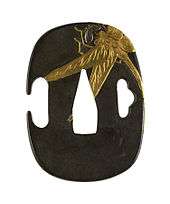Hori Bakusui
Hori Bakusui 堀麦水 (1718-1783) was a major Japanese poet of the Matsuo Bashō revival, writing traditional style haiku poems.[1]
Biography
Little is known of Bakusui's life apart from his poems. He came from Kanazawa in the middle Edo period, and studied under Otsuyu.[2] He is considered romantic by temperament, and he attempted to revive the early style of the classical Haiku poet of the previous century, Matsuo Bashō, from the book Minashiguri. in 1770 he wrote a book of laconic comments on Bashō's hokku, called Jōkyō shōfū kukai densho (Orthodox style of the Jōkyō era: Verses with critical commentary).[3]
Haiku
One of Bakusui's poems, on the popular haiku theme of the dragonfly, runs:
Dyeing his body
autumn—
the dragonfly.— Bakusui[4]
Another version on the same subject is
Dyed he is with the
Colour of autumnal days,
O red dragonfly.[5]
See also
References
- ↑ Crowley, Cheryl. "Collaboration in the 'Back to Bashō' Movement: The Susuki Mitsu Sequence of Buson's Yahantei School," Early Modern Japan, Fall 2003, page 5.
- ↑ Addiss, Stephen (2009). Haiku: An Anthology of Japanese Poems. Shambhala Publications. p. 165. ISBN 978-0-8348-2234-4.
- ↑ Ueda, Makoto (1995). Bashō and His Interpreters: Selected Hokku with Commentary. Stanford University Press. p. 418. ISBN 978-0-8047-2526-2.
- ↑ Addiss, Stephen (2009). Haiku: An Anthology of Japanese Poems. Shambhala Publications. p. 63. ISBN 978-0-8348-2234-4.
- ↑ Waldbauer, Gilbert; Waldbauer, Gilbert (30 June 2009). A Walk around the Pond: insects in and over the water. Harvard University Press. p. 247. ISBN 978-0-674-04477-7.
This article is issued from Wikipedia - version of the 7/21/2016. The text is available under the Creative Commons Attribution/Share Alike but additional terms may apply for the media files.
